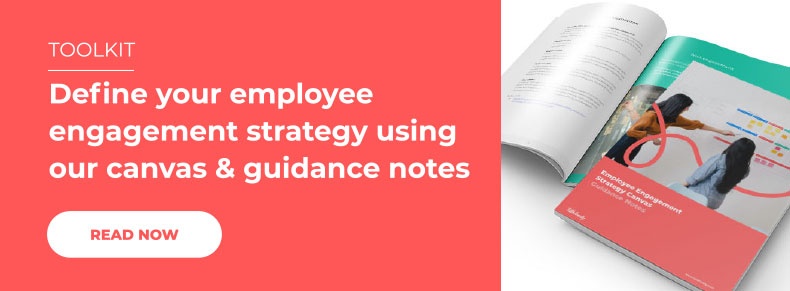Employee engagement has made it to the top of the priority list. Not so long ago, it was considered a nice-to-have. Now, in the post-pandemic world, employee engagement is ranked almost as highly as performance and profitability. Why? Because it is intrinsically related to both. A fully engaged employee will deliver a top performance that rakes in the profits.
This means that finally, organisations are ploughing time, effort and budget into their employee engagement strategies. But, the big question is whether all this investment is paying off. How can you assess whether your employees are connecting with the communications you send out? Are they being received, read, understood, and acted upon? What are the metrics for employee engagement?
How to measure employee engagement? Unless you are actively monitoring, you’re shooting in the dark. It’s vital to understand precisely what your employees think of the company, their jobs and their role. Research from Gartner suggests that over 90% of businesses currently measure employee engagement and consider it an essential element of their overall strategy. Measuring employee engagement helps companies achieve real increases in both revenues and profitability. In the same way that tracking sales figures help organisations to keep on target, it’s all part of the bigger picture.
In this blog, we take a closer look at the critical metrics for employee engagement. We’ll explore the questions you need to ask to get to the heart of the issue. Because keeping on top of employee engagement measurement is as important as the messages you send out in the first place. The bottom line? If your employee engagement model doesn’t have the impact you need, you’re wasting your time and money.
Employee engagement measurement tools
There are many ways to go about measuring employee engagement. You can send out an in-depth survey covering a range of fundamental questions. Alternatively, you can conduct quick polls or schedule regular ‘pulse’ surveys for a business health check. With an employee engagement platform, you’ll find it’s easy to implement all three on a rolling basis:
Survey
An employee engagement survey is undoubtedly one of the most popular tools to measure employee engagement. It can be used as a diagnostic instrument, helping to pinpoint specific hot spots, such as communication channels that have fallen out of the use or a manager who fails to communicate effectively. Surveys also allow employees to provide vital information about day-to-day operations and the areas that require improvement.
Poll
Sometimes you get the best results from keeping it short and sweet. An employee engagement app will make it simple to send out quick single-question polls to capture employee views. Perfect for gaining flash insights across departments and company-wide, a poll will instantly gather essential employee engagement statistics.
Pulse
Checking in regularly is essential if you’re going to measure employee engagement effectively. A pulse survey will allow you to measure the ongoing health of your organisation with pre-scheduled check-ups. One of the more popular employee engagement ideas is to track happiness levels with simple smileys.
Seven employee engagement metrics
So, which questions do you ask to measure actual engagement levels? After all, you can’t just ask people if they’re feeling engaged. We’ve pulled out the seven key questions that will help you assess your company's current levels of employee engagement and motivation.
Question #1: Advocacy
On a scale of zero to ten, how likely are you to recommend this organisation as a place to work?
Thisi the classic eNPS question. Your Employee Net Promoter Score is a feedback metric derived from the employee survey question above. The percentage of detractors (those who respond with a six or below) is subtracted from the percentage of promoters (those who respond with a 9 or 10) to reveal your eNPS. Considered one of the employee engagement best practices, the eNPS question is the starting point for almost every survey.
This is a compelling metric when exploring how to measure employee engagement. A promoter is not just someone who believes your company is a good place to work. They are also confident enough in the organisation’s future to recommend it to family and friends. As a rule of thumb, an eNPS of over 40 is outstanding; between 20-40 is good, and -10-20 is average. Below -10 is cause for concern.
Question #2: Loyalty
On a scale of zero to ten, how likely are you to look for a job with another company?
The ‘Great Resignation’ is not just a theory. Following the pandemic, record numbers of people are leaving their jobs. Companies have been forced to navigate this tide of leavers and re-evaluate how to retain talent. According to research by Barnett Waddingham, over 85% of UK businesses were affected by the loss of employees, placing retention at the top of the priority list.
This employee engagement metric highlights the current flight risk among your staff. However, along with employee engagement levels, resignations can also be triggered by other factors, including personal circumstances, the current working climate and the industry you’re in. Ultimately, an engaged employee is much more likely to remain in the post.
Question #3: Management
On a scale of zero to ten, how often does your manager check in with you?
There is an undeniable link between employee engagement and leadership. As the saying goes: “People leave managers, not companies”. A manager directly influences key elements of an employee’s role, from development opportunities to autonomy, reward and recognition.
While you can do plenty to encourage employee engagement initiatives amongst your staff, you still need a good manager to push the programmes through. A reward and recognition programme will only work with the right management. This makes management ability one of the key metrics for employee engagement.
Question #4: Pride
On a scale of zero to ten, how proud do you feel to work for this organisation?
There’s more to a job than just turning up to work every day. Now, more than ever, it’s essential that employees can wholeheartedly believe in the company’s purpose, values, culture and reputation. Solid company culture is one of the critical drivers of employee engagement. It’s things like this that encourage employees to go the extra mile.
Pride is an excellent way of measuring employee engagement. If you have employees who believe in their role and the company they work for, you’ll find they are more productive and therefore more profitable. They are also less likely to leave for another position. A company that encourages a sense of belonging will find it much easier to retain staff.
Question #5: Voice
On a scale of zero to ten, how much do you feel your opinions are included in decision-making?
The powerful desire to be seen and heard cannot be underestimated. If you’re wondering how to improve employee engagement instantly, this is your answer. By allowing your employees to have their ideas and suggestions heard, you’ll be driving engagement levels through the roof.
If you can build a culture around employee voice, you’re already halfway to success. How well employees feel heard is one of the best tools to measure employee engagement. With two-way feedback channels in place and opportunities to have a real influence on company strategy, employees feel valued, empowered and included.
Question #6: Recognition
On a scale of zero to ten, how much do you feel your contributions are recognised?
Not dissimilar from employee voice, recognition is an equally potent driver of employee engagement. Praise, especially when given publicly, is a very influential tool to drive up work engagement. It’s also a very cost-effective strategy. After all, it costs nothing to say ‘thank you’ for a job well done.
A good employee engagement app will have a recognition module built-in and ready to go. It makes it simple to initiate a company culture of appreciation, promoting successes across the company, and inviting co-workers to recognise and praise each other’s achievements. The extent to which employees feel recognised for their work is a solid indicator to measure employee engagement.
Question #7: Opportunities
On a scale of zero to ten, how great are the opportunities for career development?
Personal growth is a big buzzword in employee engagement right now. People are no longer content with sticking with a job that leads nowhere. Without opportunities for growth and progress, employees will often lose motivation and start casting an eye around for new openings.
Employee engagement and retention are closely linked. Ensure you check in regularly to ensure your employee’s advancement needs are met and development opportunities are properly promoted. This is where polls and pulses are particularly helpful, providing an instant picture of your workforce’s current state of mind.
How to measure employee engagement? The secret is to ask the right questions in the right way. Using these seven essential metrics, you will be well-armed with all the knowledge you need to keep on top of employee engagement and get the very best from your employees.








.jpg)
.jpg)